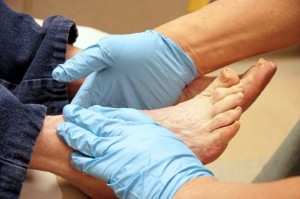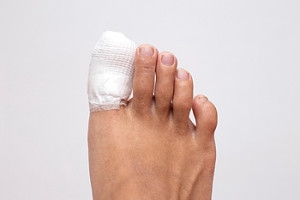
The Diabetic Foot
Diabetes is a systemic condition. This means that it affects the whole body, including the feet. Foot problems that stem from diabetes include peripheral neuropathy, a form of nerve damage, and diabetic foot ulcers, a type of open wound that can occur on the feet and become infected when left unnoticed. Between 40 and 60 million diabetics worldwide suffer from lower limb complications each year. The best way to prevent these problems is to stay vigilant of any changes in your feet by performing daily foot inspections. Look at your feet carefully and take note of anything unusual, such as cuts, scrapes, sores, discoloration, or strange sensations. If you notice that something is off, seek the care of a podiatrist as soon as possible.
Diabetic foot care is important in preventing foot ailments such as ulcers. If you are suffering from diabetes or have any other concerns about your feet, contact one of our podiatrists from Summit Podiatry. Our doctors can provide the care you need to keep you pain-free and on your feet.
Diabetic Foot Care
Diabetes affects millions of people every year. The condition can damage blood vessels in many parts of the body, especially the feet. Because of this, taking care of your feet is essential if you have diabetes, and having a podiatrist help monitor your foot health is highly recommended.
The Importance of Caring for Your Feet
- Routinely inspect your feet for bruises or sores.
- Wear socks that fit your feet comfortably.
- Wear comfortable shoes that provide adequate support.
Patients with diabetes should have their doctor monitor their blood levels, as blood sugar levels play such a huge role in diabetic care. Monitoring these levels on a regular basis is highly advised.
It is always best to inform your healthcare professional of any concerns you may have regarding your feet, especially for diabetic patients. Early treatment and routine foot examinations are keys to maintaining proper health, especially because severe complications can arise if proper treatment is not applied.
If you have any questions please feel free to contact one of our offices located in Wilmington, Whiteville, and Wallace, NC . We offer the newest diagnostic and treatment technologies for all your foot and ankle needs.
Diabetic Foot Conditions
According to the American Diabetes Association (ADA), diabetes is a condition that affects approximately 23.6 million Americans. Around 750,000 new cases are diagnosed each year, and the disease’s most common form, Type 2 diabetes, makes up for 90 to 95 percent of these cases. Type 2 diabetes is especially prevalent among older Americans, those who are obese, and those who lead sedentary lifestyles.
Complications of the disease may lead to several foot and ankle-related conditions. The loss of nerve sensation, or neuropathy, can cause diabetics to lose feeling at the bottom of the feet and therefore leave them unaware of pain, pressure, and heat. Decreased circulation is another complication of diabetes that can slow down the healing of wounds and injuries; this can lead to the development of foot ulcers.
To prevent foot ulcers from forming, diabetics should examine their feet every day for small cuts and wear shoes that curtail pressure. Constant monitoring for the risk factors associated with ulcer formation can allow for early detection and therefore lessen the possibility of ulcers or, even worse, amputation. The removal of calluses and ingrown toenails should be left to the podiatrist to avoid improper removal and possible infection.
Diabetic patients may also experience foot deformities due to complications in their feet, such as limited joint mobility, muscle atrophy, and decreased fat padding. These complications can increase pressure in certain areas of the foot, which in turn can cause certain deformities, such as hammertoe, to form. Another deformity, Charcot foot, develops due to the collapsing of microfractures in the bones of the feet. The resulting deformity is a foot that is flattened and wider in appearance.
To help minimize pressure and prevent the development of these diabetes-related foot and ankle conditions, your podiatrist may consider using orthotics or special shoes. Charcot foot may be treated using walkers, custom orthotic insoles, or non-weight-bearing or rigid weight-bearing casts or braces. In more serious cases, surgery may be considered to treat more developed deformities. Ulcers can be further cared for with the help of proper diet, medication to control glucose, intensive wound care, and infection treatment.
Taking Care of Your Feet
 Feet go through a lot of wear and tear over the course of one’s life, so it's important to take small steps to ensure their overall health. Wearing comfortable shoes is key when trying to keep your feet healthy. Shoes that are tight or lack support can lead to various types of uncomfortable foot conditions. Some of these conditions include bunions, Morton’s neuroma, ingrown toenails, and blisters. Daily walking routines help keep the muscles in your feet active, flexible, and strong, which could prevent fallen arches or other complications later on in life. Most of the time, feet spend majority of the day confined to a shoe, which can trap moisture and bacteria. Cleaning your feet daily and wearing socks helps to prevent bacterial and fungal infections. Moisturizing your feet also contributes to their health by preventing dry, cracked, or scaly skin. If you would like any additional information on how to care for your feet, then it is suggested you speak with a podiatrist.
Feet go through a lot of wear and tear over the course of one’s life, so it's important to take small steps to ensure their overall health. Wearing comfortable shoes is key when trying to keep your feet healthy. Shoes that are tight or lack support can lead to various types of uncomfortable foot conditions. Some of these conditions include bunions, Morton’s neuroma, ingrown toenails, and blisters. Daily walking routines help keep the muscles in your feet active, flexible, and strong, which could prevent fallen arches or other complications later on in life. Most of the time, feet spend majority of the day confined to a shoe, which can trap moisture and bacteria. Cleaning your feet daily and wearing socks helps to prevent bacterial and fungal infections. Moisturizing your feet also contributes to their health by preventing dry, cracked, or scaly skin. If you would like any additional information on how to care for your feet, then it is suggested you speak with a podiatrist.
Everyday foot care is very important to prevent infection and other foot ailments. If you need your feet checked, contact one of our podiatrists from Summit Podiatry. Our doctors can provide the care you need to keep you pain-free and on your feet.
Everyday Foot Care
Often, people take care of their bodies, face and hair more so than they do for their feet. But the feet are a very important aspect of our bodies, and one that we should pay more attention to. Without our feet, we would not be able to perform most daily tasks.
It is best to check your feet regularly to make sure there are no new bruises or cuts that you may not have noticed before. For dry feet, moisturizer can easily be a remedy and can be applied as often as necessary to the affected areas. Wearing shoes that fit well can also help you maintain good foot health, as well as making it easier to walk and do daily activities without the stress or pain of ill-fitting shoes, high heels, or even flip flops. Wearing clean socks with closed shoes is important to ensure that sweat and bacteria do not accumulate within the shoe. Clean socks help to prevent Athlete’s foot, fungi problems, bad odors, and can absorb sweat.
If you have any questions please feel free to contact one of our offices located in Wilmington, Whiteville, and Wallace, NC . We offer the newest diagnostic and treatment technologies for all your foot and ankle needs.
Every Day Foot Care
Our feet are important in our everyday lives. The problem is that we tend to neglect them. When this becomes a habit, it can cause significant trouble. Ignoring foot problems can mean pain, limited mobility, and expensive doctor's visits. On the other hand, if feet are cared for and looked after regularly, they will perform without pain or complication.
Routine hygiene is the most basic way to care for the feet. Wash and dry them thoroughly daily. Remember to get between the toes and keep the toenails trimmed and short. If the feet feel dry or there are signs of dryness or cracking, use a moisturizer designed for the feet.
When using moisturizer on the feet, try to avoid applying between the toes. If cream or lotion sits too long, they can cause fungal and bacterial growth. When moisturizer is used between the toes, it can also cause the skin to soften too much.
Shoes are also an important aspect of foot care. When one is picking out shoes, make sure they are the correct size. Shoes need to be snug, but not too tight. On the other hand, if shoes are too loose they can cause foot problems as well. It is highly recommended that shopping for new shoes be done later in the day. The reason for this is that the feet will have settled and swelled to their full size by then. To keep your feet at their most healthy, avoid wearing high heels or flip flops too often. Instead, choose shoes that are good for your feet. Good shoes pad the soles of your feet and support the arches and ankles.
Socks should also be worn daily with closed-toe shoes. They may feel hot during the summer months, but they absorb sweat and moisture off the feet. Without socks, the build-up of sweat in a closed-toe shoe can cause fungal problems and athlete's foot.
The best thing to remember in every day foot care is that shoes do make a difference. If you spend a lot of time on your feet, make sure that your shoes show no signs of wear. Shoes should offer ample support for the arches and the overall foot. Additionally, try to make foot cleaning and maintenance a daily habit. If you keep these things in mind, your feet will stay healthy and safe.
How to Diagnose a Stress Fracture
 A stress fracture in the foot is often referred to as a hairline fracture. It generally develops gradually, and can come from repetitive overuse. Many runners experience stress fractures, and this can cause severe pain and discomfort while running or jogging. Additionally, they may happen if medical conditions exist, which can consist of osteoporosis, bunions, or tendonitis. This condition is generally diagnosed by having a physical examination performed, which may include having an X-ray taken. Many stress fractures will heal over time when the affected foot is elevated and the activity that caused the condition is temporarily ceased. It is beneficial to wear shoes that are supportive, in addition to protecting the feet. If you feel you have endured a stress fracture of the foot, it is suggested that you speak with a podiatrist who can guide you toward correct treatment options.
A stress fracture in the foot is often referred to as a hairline fracture. It generally develops gradually, and can come from repetitive overuse. Many runners experience stress fractures, and this can cause severe pain and discomfort while running or jogging. Additionally, they may happen if medical conditions exist, which can consist of osteoporosis, bunions, or tendonitis. This condition is generally diagnosed by having a physical examination performed, which may include having an X-ray taken. Many stress fractures will heal over time when the affected foot is elevated and the activity that caused the condition is temporarily ceased. It is beneficial to wear shoes that are supportive, in addition to protecting the feet. If you feel you have endured a stress fracture of the foot, it is suggested that you speak with a podiatrist who can guide you toward correct treatment options.
Activities where too much pressure is put on the feet can cause stress fractures. To learn more, contact one of our podiatrists from Summit Podiatry. Our doctors can provide the care you need to keep your pain free and on your feet.
Dealing with Stress Fractures of the Foot and Ankle
Stress fractures occur in the foot and ankle when muscles in these areas weaken from too much or too little use. The feet and ankles then lose support when walking or running from the impact of the ground. Since there is no protection, the bones receive the full impact of each step. Stress on the feet can cause cracks to form in the bones, thus creating stress fractures.
What Are Stress Fractures?
Stress fractures occur frequently in individuals whose daily activities cause great impact on the feet and ankles. Stress factors are most common among:
- Runners
- People affected with Osteoporosis
- Tennis or basketball players
- Gymnasts
- High impact workouts
Symptoms
Pain from the fractures occur in the area of the fractures and can be constant or intermittent. It will often cause sharp or dull pain with swelling and tenderness. Engaging in any kind of activity which involves high impact will aggravate pain.
If you have any questions please feel free to contact one of our offices located in Wilmington, Whiteville, and Wallace, NC . We offer the newest diagnostic and treatment technologies for all your foot and ankle needs.
Dealing with Stress Fractures of the Foot and Ankle
Stress fractures are small breaks in the bone that are caused by repetitive stress. They typically occur due to overuse, forcing the bones of the foot or ankle to continually absorb the full impact of each step taken. Stress fractures can also be caused by abnormal foot structure, osteoporosis, bone deformities, or wearing improper footwear during exercise.
Stress fractures are common for individuals whose daily activities cause high levels of impact on their feet and ankles. Those who run, play tennis or basketball, or practice gymnastics tend to experience these fractures more frequently. Anyone is susceptible to this problem, though. Individuals who are normally sedentary and suddenly begin an intense, high impact workout may sustain stress fractures. This is because their muscles are not yet strong enough to handle and cushion the intensity of their activity. Osteoporosis may also cause someone to get stress fractures, because the disease weakens an afflicted person's bones and makes it easier for them to break down.
Pain from stress fractures typically occurs in the general area of the fracture. Pain can also manifest as “pinpoint pain” or pain that is felt when the site of the injury is touched, and can be accompanied by swelling. It may occur during or after activity, and it may disappear while resting and return when standing or moving. Engaging in any kind of activity, high impact or otherwise, will aggravate the pain. If the intensity of the activity increases before the stress fracture has properly healed, it can cause a full fracture.
Treatment can vary depending on the individual and the degree of injury. The primary way to treat a stress fracture is to rest the hurt foot. Some fractures will heal quickly with only a little bit of rest, while others may require a long rest period and the use of crutches, immobilization, or physical therapy. Under certain circumstances, surgery may be required to install support pins around the fracture to assist in healing.
If you are undergoing a new exercise regimen in running or some other kind of high impact activity, set incremental goals on a weekly basis so you can build up muscle strength. Make sure to wear supportive shoes to better protect you feet.
If you begin to experience any symptoms of stress fractures, you should stop exercising and rest. If the symptoms persist, consult with your podiatrist. Remembering these tips can help you prevent stress fractures to your foot and ankle, and allow you to continue living normally.
What Should I Do if I Broke My Toe?
 A broken toe may occur due to a sudden injury, or can develop gradually over time. If you have broken your toe, you may notice symptoms such as pain, swelling, redness, bruising, and difficulty walking. You should seek immediate medical attention if the toe is numb or badly cut or wounded, deformed, makes a snapping, popping, or grinding sound at the time of injury, or if you have severe pain. You should also seek medical care as soon as possible if you have broken your big toe. Less severe injuries can usually be managed with rest, ice, and elevation at home while you wait for an appointment with your doctor. If you suspect you may have broken your toe, please see a podiatrist.
A broken toe may occur due to a sudden injury, or can develop gradually over time. If you have broken your toe, you may notice symptoms such as pain, swelling, redness, bruising, and difficulty walking. You should seek immediate medical attention if the toe is numb or badly cut or wounded, deformed, makes a snapping, popping, or grinding sound at the time of injury, or if you have severe pain. You should also seek medical care as soon as possible if you have broken your big toe. Less severe injuries can usually be managed with rest, ice, and elevation at home while you wait for an appointment with your doctor. If you suspect you may have broken your toe, please see a podiatrist.
Broken toes may cause a lot of pain and should be treated as soon as possible. If you have any concerns about your feet, contact one of our podiatrists from Summit Podiatry. Our doctors will treat your foot and ankle needs.
What Is a Broken Toe?
A broken toe occurs when one or more of the toe bones of the foot are broken after an injury. Injuries such as stubbing your toe or dropping a heavy object on it may cause a toe fracture.
Symptoms of a Broken Toe
- Swelling
- Pain (with/without wearing shoes)
- Stiffness
- Nail Injury
Although the injured toe should be monitored daily, it is especially important to have a podiatrist look at your toe if you have severe symptoms. Some of these symptoms include worsening or new pain that is not relieved with medication, sores, redness, or open wounds near the toe.
If you have any questions, please feel free to contact one of our offices located in Wilmington, Whiteville, and Wallace, NC . We offer the newest diagnostic and treatment technologies for all your foot care needs.
What to Know About a Broken Toe
Trauma to the foot, especially the toes, can occur in many ways. Banging them, stubbing them, or dropping something on them are a few different ways this trauma can occur. Given the fact that toes are positioned in front of the feet, they typically sustain the brunt of such trauma. When trauma occurs to a toe, the result can be a painful break or fracture. Another type of trauma that can break a toe is repeated activity that places stress on the toe for prolonged periods of time.
Broken toes can be categorized as either minor or severe fractures. Symptoms of minor toe fractures include throbbing pain, swelling, bruising on the skin and toenail, and the inability to move the toe with ease. Severe toe fractures require medical attention and are indicated when the broken toe appears crooked or disfigured, when there is tingling or numbness in the toe, or when there is an open, bleeding wound present on the toe.
Generally, a minor toe break will heal without long-term complications. However, it is important to discontinue activities that put pressure on the toe. It is best to stay off of the injured toe and immediately get a splint or cast to prevent any more additional movement of the toe bones. You can also immobilize your toe by placing a small cotton ball between the injured toe and the toe beside it. Then, tape the two toes together with medical tape. Swelling can be alleviated by placing an ice pack on the broken toe directly as well as elevating your feet above your head.
Severe toe fractures may be treated with a splint, cast, and in some cases, minor surgery, especially when the big toe has been broken. Due to its position and the pressure the big toe endures with daily activity, future complications can occur if it is not properly treated. Pain associated with minor toe fractures can be managed with over-the-counter pain medications. Prescription pain killers may be necessary for severe toe fractures.
The healing time for a broken toe is approximately four to six weeks. In severe cases where the toe becomes infected or requires surgery, healing time can take up to eight weeks or more. While complications associated with a broken toe are immediately apparent, it is important to note that there are rare cases when additional complications, such as osteoarthritis, can develop over time. You should immediately speak with your podiatrist if you think you have broken your toe due to trauma. They will be able to diagnose the injury and recommend the appropriate treatment options.
Indications of Plantar Fasciitis
 If you have heel pain that is worse in the morning, after long periods of standing, or after working out, you may have plantar fasciitis. Plantar fasciitis is a result of inflammation or a partial tearing of the tissue band that runs along the bottom of the foot, known as the plantar fascia. Plantar fasciitis is normally an overuse injury that comes from activities that put stress on the plantar fascia (like running). Because of this, the pain from plantar fasciitis usually gets worse over time. Other factors that may lead to plantar fasciitis include obesity, flat feet, high arches, or tight calf muscles. Because of the negative impact that plantar fasciitis can have on everyday activities, patients that are struggling with heel pain should consult with a podiatrist for a proper diagnosis and treatment plan.
If you have heel pain that is worse in the morning, after long periods of standing, or after working out, you may have plantar fasciitis. Plantar fasciitis is a result of inflammation or a partial tearing of the tissue band that runs along the bottom of the foot, known as the plantar fascia. Plantar fasciitis is normally an overuse injury that comes from activities that put stress on the plantar fascia (like running). Because of this, the pain from plantar fasciitis usually gets worse over time. Other factors that may lead to plantar fasciitis include obesity, flat feet, high arches, or tight calf muscles. Because of the negative impact that plantar fasciitis can have on everyday activities, patients that are struggling with heel pain should consult with a podiatrist for a proper diagnosis and treatment plan.
Plantar fasciitis is a common foot condition that is often caused by a strain injury. If you are experiencing heel pain or symptoms of plantar fasciitis, contact one of our podiatrists from Summit Podiatry. Our doctors can provide the care you need to keep you pain-free and on your feet.
What Is Plantar Fasciitis?
Plantar fasciitis is one of the most common causes of heel pain. The plantar fascia is a ligament that connects your heel to the front of your foot. When this ligament becomes inflamed, plantar fasciitis is the result. If you have plantar fasciitis you will have a stabbing pain that usually occurs with your first steps in the morning. As the day progresses and you walk around more, this pain will start to disappear, but it will return after long periods of standing or sitting.
What Causes Plantar Fasciitis?
- Excessive running
- Having high arches in your feet
- Other foot issues such as flat feet
- Pregnancy (due to the sudden weight gain)
- Being on your feet very often
There are some risk factors that may make you more likely to develop plantar fasciitis compared to others. The condition most commonly affects adults between the ages of 40 and 60. It also tends to affect people who are obese because the extra pounds result in extra stress being placed on the plantar fascia.
Prevention
- Take good care of your feet – Wear shoes that have good arch support and heel cushioning.
- Maintain a healthy weight
- If you are a runner, alternate running with other sports that won’t cause heel pain
There are a variety of treatment options available for plantar fasciitis along with the pain that accompanies it. Additionally, physical therapy is a very important component in the treatment process. It is important that you meet with your podiatrist to determine which treatment option is best for you.
If you have any questions, please feel free to contact one of our offices located in Wilmington, Whiteville, and Wallace, NC . We offer the newest diagnostic and treatment technologies for all your foot care needs.








